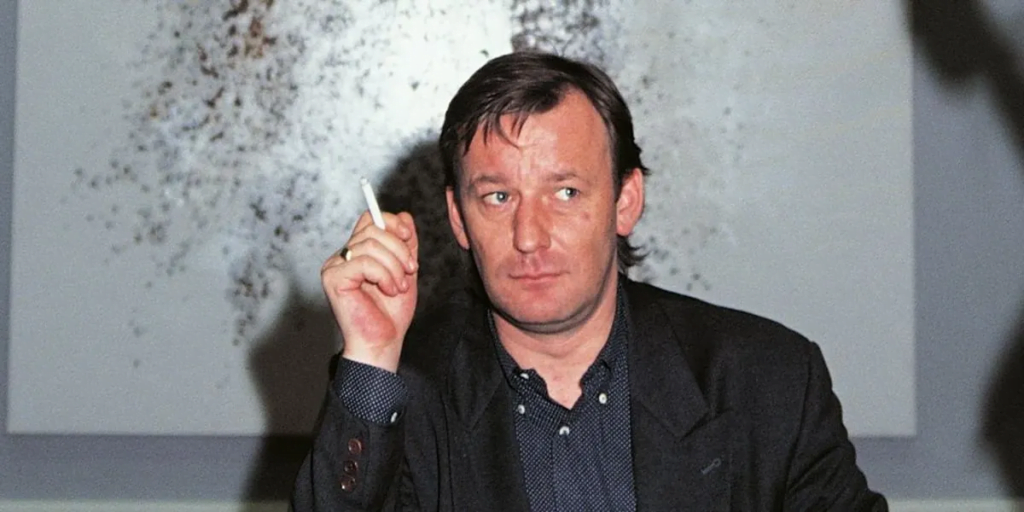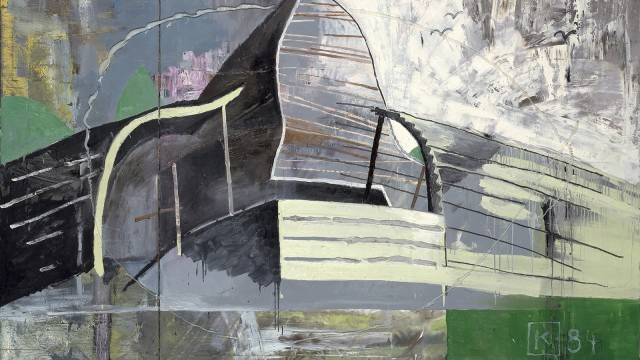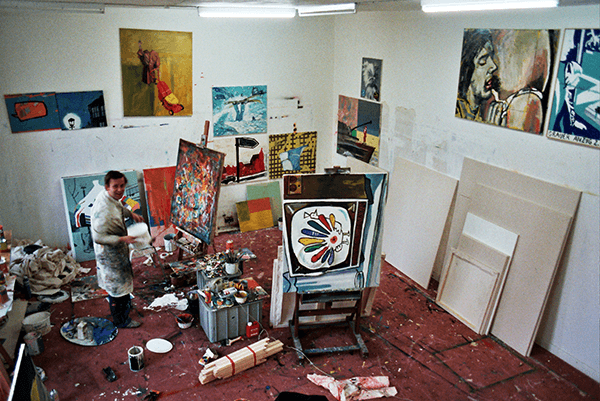As an artist, Martin Kippenberger challenged conventions and provoked controversy. Throughout his career, Kippenberger pushed the boundaries of art through conceptual works that incorporated punk sensibility and absurdist humour. His life was cut short at the young age of 44, yet in that time; he produced an astonishing body of work that has cemented his status as one of the most influential German artists of the generation.
While his art was only sometimes immediately understood or appreciated, he is recognized as one of his generation’s most influential German artists today. His life inspires us, reminding us of the power of unbridled self-expression and creativity.
This article will explore your unconventional life, rebellious art, and enduring impact on contemporary art. Prepare to delve into the provocative world of Martin Kippenberger, the punk provocateur.
Martin Kippenberger BIOGRAPHY

Early Life and Education: The Rebellious Upbringing of Martin Kippenberger
Martin Kippenberger’s rebellious nature was apparent from an early age. Born in 1953 in Dortmund, Germany, to a wealthy family, Kippenberger rebelled against the strict rules and expectations of his father, a coal mining executive. His tumultuous upbringing and tense relationship with his father likely contributed to his provocative and anti-authoritarian personality.
Kippenberger began studying at the Hochschule für bildende Künste Hamburg in 1972 but dropped out after only one semester. He then looked at the Akademie in Vienna but was expelled after vandalizing another student’s work. Despite his lack of formal training, Kippenberger was extraordinarily prolific and produced massive paintings, drawings, sculptures, collages, photographs, and performance pieces throughout his career.
In 1976, Kippenberger moved to Berlin, where he became involved in the punk music scene. He inspired his art with music, nightlife, and social circles. His home in Berlin became a central meeting place for artists and musicians. Kippenberger travelled frequently during this time, connecting with artists around the world. These experiences abroad, combined with the political and social environment of 1970s Germany, shaped Kippenberger’s skeptical and irreverent views toward authority and traditional social conventions.
Kippenberger’s rebellious spirit and lack of respect for traditional artistic practices defined his prolific career. While controversial, his work provides insightful social commentary on authority, political and social norms, and creative originality. Tragically, his life was cut short in 1997 at 44 due to liver cancer caused by excessive drinking. However, Kippenberger’s impact on contemporary art remains formidable. His provocative and unconventional work made him a pivotal figure in 20th-century art.
What is Martin Kippenberger known for?

Martin Kippenberger pushed boundaries and challenged conventions through his highly conceptual and often controversial paintings, sculptures, drawings, and installations. Kippenberger lived a short but impactful life, channelling his restless energy and rebellious spirit into his provocative art. Though he struggled with substance abuse and turbulent relationships, his prolific work is a testament to his creative passion.
Career highlights

Kippenberger’s Artistic Style: Punk Esthetic Meets Conceptual Commentary
Kippenberger was known for “collisions” of images and objects that created chaos and disruption. Kippenberger frequently appropriated well-known photos and objects, using them ironically and provocatively. Similarly, his “paintings” combined fragments of posters, newspapers, and letters in chaotic collages.
1988 | “Untitled” | This work appropriate and manipulate familiar images, infusing them with new meaning. |
1989 | “Martin, Into the Corner, You Should Be Ashamed of Yourself” | It features the artist himself facing a corner, parodying a familiar childhood punishment. His irreverent use of self-portraiture undermines the self-importance of traditional portraiture. |
Though controversial, Kippenberger’s punk esthetic and conceptual commentary were ahead of their time, pioneering ideas that remain influential today.
Critical Reception
Critics were divided in their opinions of Kippenberger’s work. Some praised his irreverence and rejection of artistic convention. Others dismissed his art as vulgar, ugly, and lacking skill or meaning.
His provocative and absurdist sculptures and installations were seen as affronts to good taste by his detractors. For example, his sculpture “Martin, Into the Corner, You Should Be Ashamed of Yourself” was criticized as ridiculous and nonsensical. His constant self-promotion and “bad boy” image led some to view him as an artistic charlatan concerned primarily with shocking audiences.
Martin Kippenberger List of Work

Major Works and Exhibitions: Kippenberger’s Provocative Pieces
Martin Kippenberger was known for pushing boundaries with his irreverent and thought-provoking works.
Two of his most well-known and controversial pieces were exhibited in 1993.
The Happy End of Franz Kafka’s “Amerika” | It featured a 60-foot-long model of a metro train and platform. The work was inspired by Kafka’s unfinished novel about a young man’s bizarre experiences in New York. Kippenberger aimed to capture the alienation and disorientation of modern life. Viewers could walk through the train and peer into detailed scenes featuring mannequins representing different social classes. The sprawling installation highlighted Kippenberger’s sardonic and exaggerated style. |
The Problem Perspective | It featured a 20-foot-high wooden sculpture of a Greek temple precariously balanced on the edge of a vertical drop. The work appeared as if it could topple over at any moment, symbolizing the fragility of tradition and stability. Its immense size and illusion of danger and unease left a memorable impression on viewers. |
These monumental and unsettling works solidified Kippenberger’s reputation as a radical and influential figure in contemporary art. His ability to provoke discomfort and reflection through paradox, irony and dark humour set him apart from his peers. Kippenberger aimed to make people question their assumptions and see the world in new, unsettling ways. While controversial, his works have enduring power and relevance.
Through major exhibitions, installations and sculptures, Kippenberger established himself as a dissident artist who pushed the boundaries of contemporary art. His provocative and sardonic works left a lasting impact and influence on art in the 20th century and beyond.
Retrospectives of his work at major museums, including:
Tate Modern in 2006
MoMA in 2009
Relationships and Collaborations: Connections With the Cologne Art Scene
Martin Kippenberger was deeply embedded in the Cologne art scene, where he maintained close associations and collaborations with other artists.
The “Kippenberger Boys”
Kippenberger surrounded himself with a circle of like-minded artists, notably Albert and Markus Oehlen and Werner Büttner, known collectively as the “Kippenberger Boys.” They lived and worked together, influencing each other’s irreverent styles. His friendship with Albert Oehlen was particularly close, and they travelled together and organized joint exhibitions.
Supporting Fellow Artists
Kippenberger was keen to promote other artists and brought attention to their work. He organized exhibitions for Büttner, Oehlen, and Georg Herold at his galleries. His publishing company, Bongo Betty, produced artists’ books collaboratively with Oehlen, Herold, and painter Dirk Skreber. Kippenberger gave Skreber one of his galleries as an exhibition space, evidencing his generosity toward fellow artists.
The Cologne Art Academy
Kippenberger maintained connections with his alma mater, the Cologne Art Academy, and taught there briefly. His teaching and broader impact on the city’s art scene influenced subsequent generations of students. His excessive lifestyle and rebellious antics became infamous, leaving their mark on the academy’s culture.
A Complicated Influence
Kippenberger’s influence on the Cologne art world was complex. While he supported many fellow artists, he was also competitive and aggressive. His outrageous and offensive behaviour alienated some, though his charisma and excessiveness held appeal for others. Kippenberger’s deep involvement in Cologne’s inspiring and antagonizing art scene was instrumental in propelling its significance. His complicated and indelible impact on the city and its artists endures.
